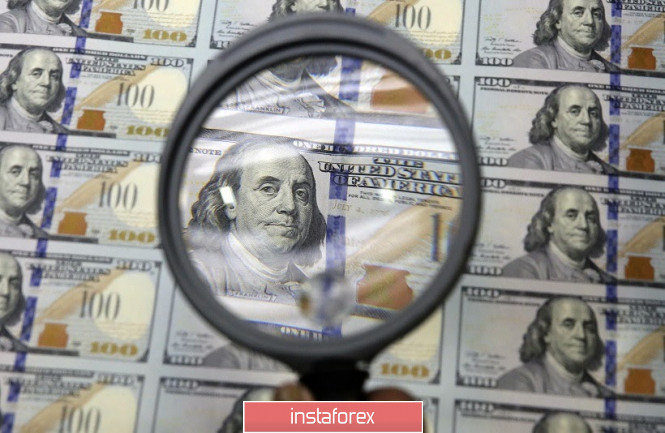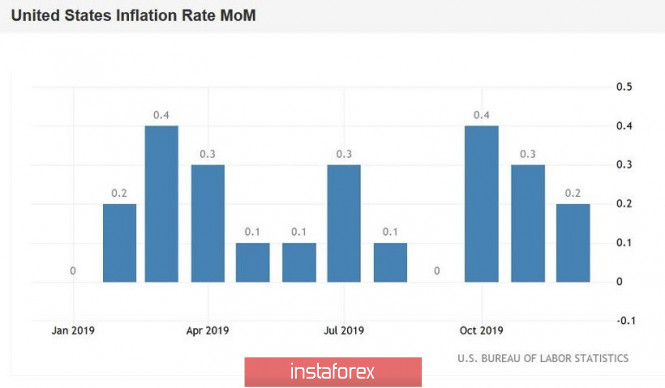The euro-dollar pair reacted minimally to conflicting data on the growth of US inflation. Almost all components reached the forecast level, but some of the nuances of the release are nevertheless alarming, especially with regard to the dynamics of wage growth. In general, nothing catastrophic happened: the indicators were not impressive, but at the same time they didn't particularly disappoint. Immediately after the publication of the data, the pair fell to the bottom of the 11th figure, as they say, "seizing the moment." But since there were no obvious reasons for optimism, sellers were not able to push the price into the area of the 10th figure. By and large, the pair remained almost at the same positions as before the release. What is the reason for such apathetic traders? In my opinion, such price dynamics are due to several fundamental factors.

Firstly, the inflation release as a whole turned out to be at the expected level. The monthly average consumer price index slowed down to 0.2%. The negative dynamics here can be traced for the second month in a row, after the index reached 0.4% in October. The indicator has grown in annual terms, thereby continuing the positive trend, which has been recorded for the third consecutive month. If the indicator reached 1.7% in September, then it rose to 2.3% in December. Most experts expected to see it slightly higher (2.4%), but the trend itself is important here.
If we talk about the core consumer price index (that is, excluding food and energy prices), then the situation here is also "neutral-contradictory" in nature. On a monthly basis, the index did not reach the forecast values (+0.1% instead of the planned +0.2%), but in annual terms, it completely coincided with the expectations of most experts (an increase of up to 2.3%, as in the previous two months).
Salaries significantly disappointed. This component probably kept the EUR/USD pair from falling into the 10th figure. After the publication of rather weak Nonfarms, today's figures only supplemented the negative picture in this area. The growth rate of the real average weekly wage came out at zero, while in the previous month this indicator came out at 0.8%. The growth rate of the real average hourly wage also turned out to be lower than forecasts - the growth was 0.6%, while analysts had expected a jump to 1.1%. According to some experts, there is no need to panic - during the pre-Christmas and New Year period, the employment of seasonal workers increased in the US, and this factor of a seasonal nature, apparently, was not taken into account with appropriate adjustments. On the other hand, the Nonfarms inflation component entered the red zone: the average hourly wage was at 0.1% on a monthly basis (the worst result since September last year, when it dropped to zero) and 2.9 % per annum (the weakest figures since July 2018).
Thus, the EUR/USD bears had no good reason for the downward dynamics. On the one hand, the release could have been much worse (taking into account the dynamics of indirect inflation indicators), on the other hand, today's figures may have a corresponding effect on the position of the Federal Reserve members regarding monetary policy prospects, especially against the background of sluggish Nonfarms. Jerome Powell has repeatedly said that the regulator will begin to raise interest rates only if inflation demonstrates "dynamic and steady growth." Obviously, today's data does not meet the specified criteria.

Nevertheless, the dollar is still holding the defense. Traders seem to be nervous about tomorrow's events. Let me remind you that on Wednesday, the first phase of the trade deal between the United States and China should be signed in Washington. The first details of this agreement appeared in the Chinese press. According to them, it includes Beijing's reassurance that China will acquire US goods in four industries for a total of $200 billion over two years. In addition, the Chinese side pledged to purchase a substantial amount of US industrial products ($75 billion), energy - $50 billion, agricultural products - $40 billion. China also agreed to spend 35 billion on purchases in the US services sector. The signing ceremony will take place at the White House, although Trump said yesterday that she could be postponed "to a later date."
In anticipation of this historic event, the market is clearly nervous, and this fact is reflected in the dynamics of the US currency. Nevertheless, short positions in the pair now look extremely risky. After the first emotions about the conclusion of the deal settle down, the focus of the market will again shift to macroeconomic statistics. This means that the dollar continues to be vulnerable, despite certain outbursts of interest in this currency.
Technically, the EUR/USD pair continues to be on the middle line of the BB indicator on the daily chart, although today the bears tried to pull down the price. However, the downward movement is accompanied by oncoming resistance, and now it is impossible to talk about the prospects for the downward impulse. The situation remains in limbo, so at the moment it is advisable to take a wait-and-see attitude in view of the increased uncertainty in anticipation of tomorrow's events.
The material has been provided by InstaForex Company - www.instaforex.com